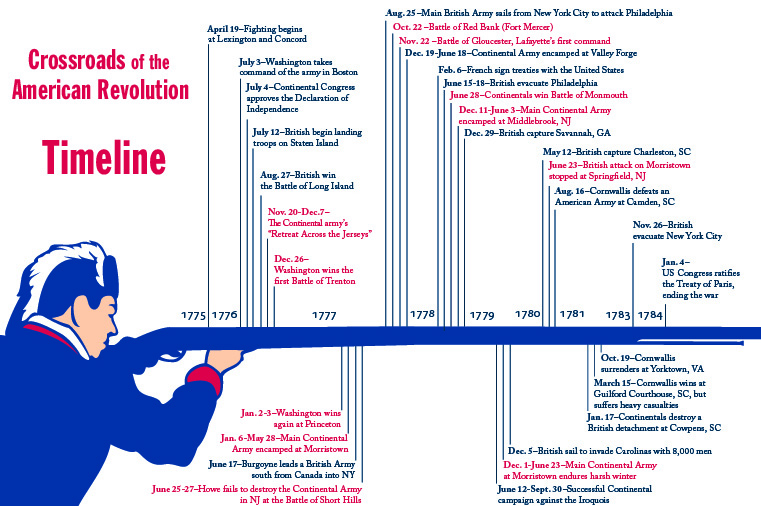New Jersey played a crucial role in the American Revolution. Positioned between the new nation’s capital in Philadelphia and the British stronghold in New York, no place in New Jersey was spared the ravages of war. During six years of conflict, General George Washington and the Continental Army spent more days in New Jersey than any other state. By the time victory was won, the fight for American independence touched every community in New Jersey. More than just a crossroads on the map, New Jersey became the crossroads in the birth of a nation.
For the British, central New Jersey offered a direct overland route connecting New York with Philadelphia and the southern colonies. But for the Continental forces, New Jersey was an unassailable fortress, with the Watchung Mountains providing an extended natural rampart shielding it from surveillance and offering a safe route linking New England with states to the south.
The National Park Service’s American Battlefield Protection Program lists 296 significant military engagements within the state, in addition to hundreds more skirmishes from 1775 through 1783.
Key events that determined the course of the war occurred here:
- the Battles of Trenton and Princeton, which changed the British strategy from offense to defense;
- the Battle of Monmouth, which demonstrated the Continental army’s ability to stand toe to toe with the British army as an equal;
- the Middlebrook Encampments,which provided a strategic, protected position that ultimately contributed to the army’s success; and
- the terrible winters at Morristown, which tested the army’s ability to survive.
Here in New Jersey, the fledgling Continental army teetered on the brink of disaster, but somehow emerged stronger. And it was in New Jersey that the mighty British army’s vulnerabilities were revealed.
Just as it is today, what happened in New Jersey was a microcosm of the national experience. For the residents of New Jersey, the fight for American Independence meant eight years of civil war. Both armies vied for the food, forage, wood, and other resources that the countryside could provide and launched disruptive forays against each other.
New Jersey’s population was culturally diverse, dispersed and primarily agrarian. The ravages of occupation forced a reluctant population to take sides. Bitter divisions developed within communities. Ad hoc militias waged unconventional warfare. Neighbor turned upon neighbor and allegiances shifted with the fortunes of war. Here, through endurance and survival, a nation was born.
New Jersey’s Revolutionary experience is not one of glory and easy triumph. It is an authentic experience represented by significant victories and small tragedies; of heroism on the battlefield and conflict in communities across the state. It is characterized by controversy, endurance, and survival. The story of the Crossroads of the American Revolution lives on in the places and people of New Jersey.

Timeline
Then, as now, New Jersey straddled roads connecting north and south. In 1775 and 1776, state regiments marched north. During November and December 1776, the remnants of the main Continental Army fled south across New Jersey, pursued by a British army. Just a month later, they retraced part of their route to defeat German and British detachments in Trenton and Princeton and march on to Morristown. This was the first of three winters that the Continental Army spent in New Jersey.
From July 1776 until November 1783, a British, German and Loyalist army occupied Staten Island, western Long Island and Manhattan, launching expeditions to collect supplies, probe local defenses and attack the Continental Army. Between January and June of 1777, skirmishes were fought up and down the Raritan River, as Continentals sought to limit British foraging and the British attempted to lure the Continentals from the safety of the Watchung Mountains. When Washington eluded them, the British withdrew from the Raritan Valley to attack Philadelphia.
The September 1777, British occupation of Philadelphia brought the war to southern New Jersey. Fierce battles were fought for control of the Delaware River and surrounding countryside. On June 18, 1778, the British army evacuated Philadelphia and began marching toward New York, as Washington led the Continental Army eastward from Valley Forge. The resulting Battle of Monmouth was the last time the two armies met in New Jersey. In 1780, the British moved offensive operations to the south.
The war was not over for New Jersey even then. In June 1780, the New York garrison launched two large probes to test the Continentals at Morristown-probes that resulted in the burning of Springfield and Connecticut Farms. Along the coast, small British and Loyalist units continued pinpoint attacks. One of the American Revolution’s last skirmishes was fought December 27, 1782, at Cedar Bridge, Ocean County.
In August 1781, the French and Continental armies marched across New Jersey toward Yorktown and victory. Two years later, after a peace treaty was signed in Paris, word reached the Continental Congress, assembled in Princeton, on November 1, 1783.
